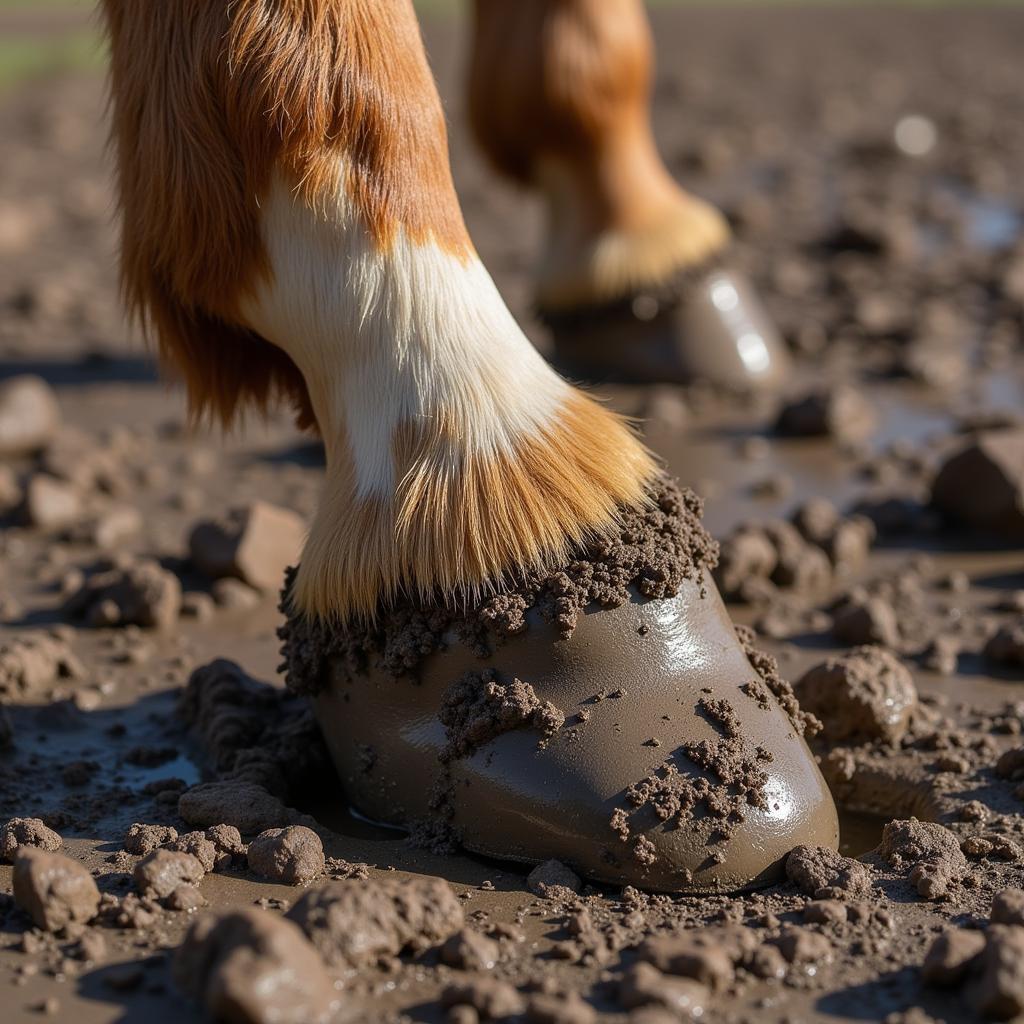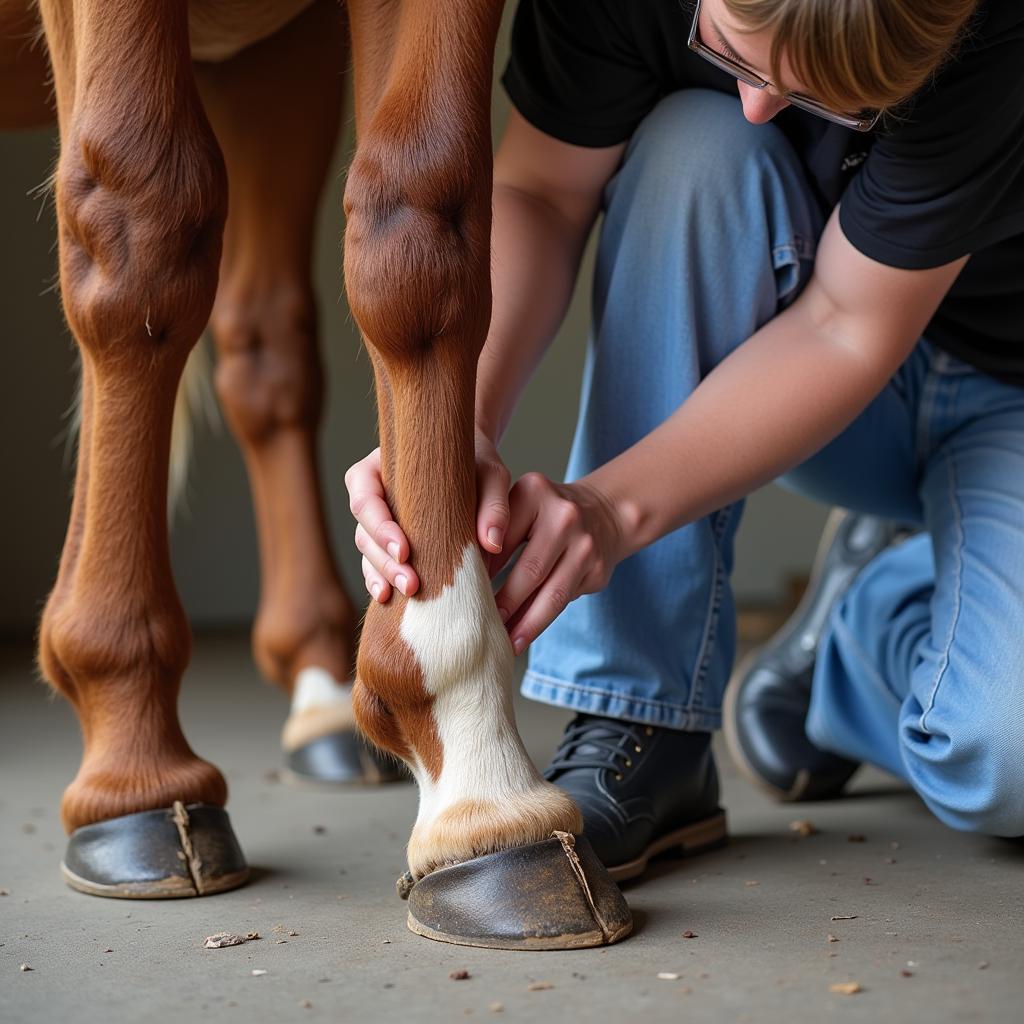Horse Hoof Hair, often a source of curiosity and sometimes concern for horse owners, refers to the long, coarse hairs that grow around the coronary band and heels of a horse’s hoof. Understanding their function and proper care can contribute significantly to your horse’s overall hoof health. Let’s delve into the world of horse hoof hair and uncover its secrets.
The Purpose of Horse Hoof Hair
These hairs, also known as fetlock feathers or ergots, aren’t just decorative. They serve a vital purpose in protecting the delicate coronary band, which is responsible for hoof growth. The hoof hair acts as a sensory organ, helping the horse detect changes in terrain and potential hazards. Additionally, the hair helps to wick away moisture and debris, keeping the area clean and dry, thus reducing the risk of infection. Like the whiskers on a sooty horse, hoof hair plays an important role in a horse’s sensory perception.
How Hoof Hair Protects the Coronary Band
The coronary band is a crucial part of the hoof, constantly generating new hoof horn. Damage to this area can lead to deformities or lameness. Hoof hair acts as a natural barrier, cushioning the coronary band against bumps and scrapes. It also helps to divert water and mud, preventing the area from becoming excessively wet and soft, which can make it more susceptible to injury. This is especially important for horses living in wet or muddy environments.
 Horse hoof hair covered in mud, demonstrating its role in protecting the coronary band in challenging environments.
Horse hoof hair covered in mud, demonstrating its role in protecting the coronary band in challenging environments.
Caring for Horse Hoof Hair
While some owners choose to trim or clip hoof hair for aesthetic reasons, it’s generally recommended to leave it intact. Excessive trimming can compromise the protection it offers. However, regular cleaning is essential. Dirt and mud can become matted in the hair, trapping moisture and potentially leading to fungal or bacterial infections. Proper grooming, including regular cleaning of the horse heel bulb and surrounding area, is crucial.
Cleaning Horse Hoof Hair: A Step-by-Step Guide
- Pick out any debris or matted mud using a hoof pick.
- Use a stiff brush to remove loose dirt and dust.
- If necessary, wash the area with a mild soap and water solution. Be sure to rinse thoroughly.
- Dry the area completely.
- Apply a hoof conditioner or moisturizer if needed, especially during dry weather. Keeping a well-stocked grooming box horse is essential for maintaining healthy hooves.
“Leaving the hoof hair untrimmed provides the best natural protection for the coronary band,” advises renowned equine veterinarian Dr. Emily Carter. “Regular cleaning is key to preventing infections and maintaining overall hoof health.”
When to Consult a Veterinarian
While hoof hair typically requires minimal care, there are instances when veterinary attention is necessary. Excessive hair loss, swelling, discharge, or signs of lameness should be promptly addressed. These could indicate an underlying infection or injury that requires professional treatment. This is especially true for breeds like the black silver horse, which can be prone to specific hoof conditions.
 Veterinarian examining a horse's hoof for signs of infection.
Veterinarian examining a horse's hoof for signs of infection.
“Early intervention is crucial in addressing hoof problems,” explains Dr. Carter. “Ignoring seemingly minor issues can lead to more serious complications down the road.”
Conclusion
Horse hoof hair, often overlooked, plays a vital role in protecting the delicate coronary band and maintaining hoof health. Understanding its function and implementing proper care, including regular cleaning and monitoring, are essential for every horse owner. By prioritizing hoof health, you contribute to your horse’s overall well-being and ensure they can enjoy a long and active life. Remember to check out the best horse shows 2023 for a chance to see these magnificent animals in action.
FAQ
- What is the main function of horse hoof hair? To protect the coronary band from injury and infection.
- Should I trim my horse’s hoof hair? It’s generally best to leave it untrimmed, but regular cleaning is essential.
- What are signs of a hoof infection? Swelling, discharge, lameness, and excessive hair loss.
- How often should I clean my horse’s hoof hair? Regular grooming, ideally daily, is recommended.
- What should I do if I notice a problem with my horse’s hoof? Consult a veterinarian immediately.
- Can hoof hair grow back if it’s trimmed? Yes, it will typically grow back.
- Is hoof hair different between breeds? The length and density can vary slightly between breeds.
When you need support please contact Phone Number: 0772127271, Email: [email protected] Or visit us at: QGM2+WX2, Vị Trung, Vị Thuỷ, Hậu Giang, Việt Nam. We have a 24/7 customer service team.